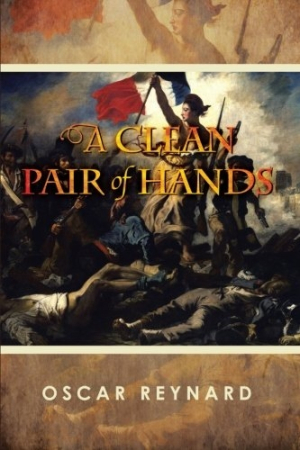
A Clean Pair of Hands
Dialogue that bounces between characters like real-life conversation pulls readers into the heart of the action in this allegorical historical novel.
A Clean Pair of Hands is Oscar Reynard’s cautionary novel about how societal ills can have massive consequences on individual lives. The novel is based on the premise of the French people’s individualism and distrust of the government, and the government’s lack of transparency with the people. Chapter titles, including thematic titles and the year(s) of the story, showcase the epic scope of the novel—spanning from the 1950s to 2014, from Paris to Haiti, from family to greed to consequences.
Protagonist Michel Bodin lives a comfortable life with his wife, Charlotte, but his thirst for pleasure and adventure takes him far from home and has disastrous consequences for his family. The themes of distrust and suppressing the truth are mirrored in the Bodins’ marriage and the relationship between the French people and their government. Reynard sets the stage for these parallels in the foreword and uses dialogue from various characters to show how they see the government and Michel’s actions.
While the book’s intent is to be the story of a couple on the backdrop of historical and cultural mores, occasionally, history and culture come to the forefront, overshadowing the personal events. At these times, the book feels more like a fable than a novel, using a specific narrative to make a broad point.
The pace varies, going quickly over minor plot points and slowing at key moments—the date ranges in the chapter titles help readers see the shifting pace at a glance.
The preface begins in a journalistic third-person perspective, recounting events of a robbery at the Bodins’ house in Paris—a critical turning point in their marriage. When the dialogue begins, the story becomes more urgent and engaging. This is consistent with the strengths and weaknesses of the book as a whole: the strongest moments of novelistic narration—which put readers in the heart of the action, seeing things on the human rather than omniscient level—are driven by strong dialogue with realistic wording and cadence that bounces between characters like typical conversation.
The novel’s weakest points are when it takes the view of a journalist or historian, telling great swaths of emotional events in fact-driven sentences. These passages are particularly detrimental to the flow of the book when they occur at the beginning of chapters—a chapter switch breaks the action, and the distant narration slows readers rather than plunging them into the forward motion of the plot.
It’s tough for eyes to choose a focal point on the cover. The image is a familiar painting of the French Revolution, and while the book is set in France and explores the French ideals that emerged from the Revolution, readers expecting the book to be about this period will be disappointed that it takes place in the twentieth and twenty-first centuries. The title type doesn’t stand out well from the image, and the back panel type is very light.
Along with the other characters who surround the Bodins, readers will wonder about Michel’s motives and choices: “Do you really think he gave up his family completely to disappear into some obscure hiding place, never to emerge?” Reynard’s motives are much more transparent; his aim is to show the consequences of choices forged by distrust and self-gratification. This book will resonate well with cynical Francophiles and those who see clearly the moral ill woven into modern society.
Reviewed by
Melissa Wuske
Disclosure: This article is not an endorsement, but a review. The publisher of this book provided free copies of the book and paid a small fee to have their book reviewed by a professional reviewer. Foreword Reviews and Clarion Reviews make no guarantee that the publisher will receive a positive review. Foreword Magazine, Inc. is disclosing this in accordance with the Federal Trade Commission’s 16 CFR, Part 255.
